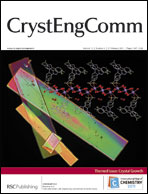The growth of highly crystalline, idiomorphic potassium titanoniobate crystals by the cooling of a potassium chloride flux†
Abstract
Highly crystalline, well-developed potassium titanoniobate (KTiNbO5 and KTi3NbO9) crystals were successfully grown at temperatures ranging from 700 to 1000 °C by a KCl flux cooling method. Colourless and transparent KTiNbO5 crystals with a smallest average size of 750 nm were grown at a relatively low temperature of 700 °C. The sizes of grown crystals were observed to greatly dependent on the holding temperature and solute concentration. HRTEM observations indicated that the flux-grown KTiNbO5 crystals were of high quality. The band gap energies of the fabricated KTiNbO5 and KTi3NbO9 crystals, as estimated from their absorption edges in

- This article is part of the themed collection: Crystal Growth

 Please wait while we load your content...
Please wait while we load your content...